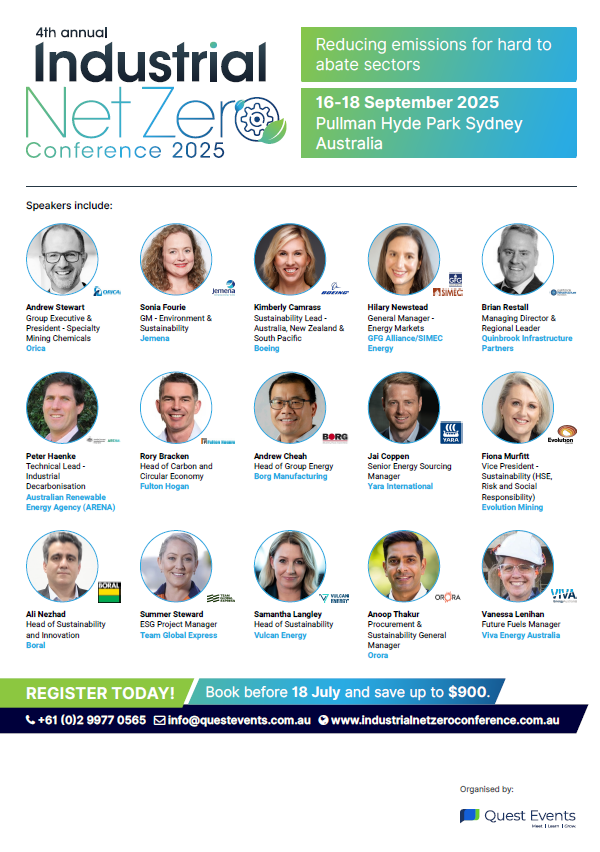Article: Making low-carbon products commercially compelling
.png?width=686&height=529&name=header%20inz%20(4).png)
By Kirstin Crothers
Turning sustainability into a competitive advantage
In the push to decarbonise, producing low-emissions products is no longer the hardest part. For emissions-intensive sectors, the real challenge is finding buyers willing to pay a premium—or even break even—on goods that cost more to make but emit far less.
As carbon-conscious procurement and ESG reporting gain traction globally, businesses that market these products effectively are gaining an edge. According to Samantha Langley, Head of Sustainability at Vulcan Energy, sustainability credentials are now integral to long-term commercial relationships.
“Price and quality are no longer the only considerations – sustainability is equally, if not more important,” she says. “The world is racing towards electrification, and Vulcan is proving sustainability isn’t a compromise; it’s a competitive advantage.”
With a high-quality lithium hydroxide product produced from geothermal brine, Vulcan has secured offtake agreements of up to ten years with key European partners. “From 2035, all new cars and vans registered in the European Union are set to be net zero emissions,” Langley notes, highlighting how regulation is helping to unlock demand for low-carbon materials.
Aligning with customer priorities
One consistent message from across the sector is that low-emissions products must be positioned as solutions to customers’ own challenges—whether that’s meeting Scope 3 targets, accessing ESG-aligned finance, or responding to brand pressure.
“Align product attributes with customer objectives,” says Anoop Thakur, General Manager – Procurement & Sustainability, Asia Pacific, Orora. “Clearly articulate the customer challenges addressed by low-emissions or sustainable offerings.”
This includes backing up claims with evidence. “Provide verifiable evidence—such as certifications—to support sustainability claims,” Thakur adds. “Foster coalitions and pursue joint market development initiatives.”
Rebecca Irwin, Sustainability and Corporate Affairs Executive, reinforces the importance of partnerships. “It really comes down to knowing your customers and building partnerships with them,” she says. “Many customers will have their own net zero goals, so knowing what your customers' goals are and aligning around them can build a long term partnership.”
This may mean starting small. “Often that partnership might start with a pilot project or a trial run,” Irwin says. “Together you can test whether what works with one customer may have appeal across a broader market.”
She also highlights the growing scrutiny on ESG claims. “The other key challenge for a manufacturer is being clear on your data and how you verify what the carbon footprint of your product is. That becomes increasingly important in a world where claims of greenwashing are on the rise.”
Data builds trust, storytelling drives value
In a crowded market, differentiation relies on both transparency and narrative. “Low-emission products often cost more to produce, and securing buyers isn’t guaranteed. So how do you make the case? Start with radical transparency,” says Shayna Jones, Product Stewardship Manager at Big Bag Recovery.
“At Big Bag Recovery, we track and trace every bag, recycle onshore in Australia, and validate our outputs through regular testing,” she explains. “By supplying verified data and showing where the value goes—into pallets, chairs, and water evaporation discs—we help buyers justify the cost and meet ESG goals.”
Jonathan Pooch, Managing Director of DETA Consulting, agrees that trust is foundational. “For marketing low-emissions products, emphasising authenticity, transparency, and environmental benefits is key,” he says.
Pooch sees additional opportunities in group purchasing models and certifications. “Hard-to-abate industries can create demand by leveraging certifications, storytelling, and group purchasing mechanisms, which reduce costs and provide demand certainty, making the business case more compelling.”
Reframing the value equation
Sustainability strategies often stumble when framed as moral imperatives rather than economic ones. But Ben Burge (ex Telstra Energy), says it’s possible—and necessary—to bridge that gap.
“If you can’t overcome the ‘sustainability v. economics’ mentality, quit your job,” Burge says bluntly. “In industrial settings, the intersection of physics, economics, commodity exposure and capital markets is a gift.”
He suggests repositioning sustainability not as a cost, but as a hedge against risk and volatility. “Reframe your strategy in terms of earnings volatility, long tail risk and compression of cost of capital, without mentioning ‘sustainability’,” he says. “Save the planet as a byproduct of increasing returns to your investors, not the other way around. It doesn’t make the result any less noble.”
Hilary Newstead, General Manager – Energy Markets at GFG Alliance/SIMEC Energy, adds that industry needs to step up its communications game. “Breaking through customer inertia requires more than compliance messaging; we must position low-embodied carbon products as strategic enablers of customers’ own climate goals and brand value,” she says.
“Collaboration and co-design with customers and industry partners, combined with a mindset of continuous innovation, help ensure these products are fit for purpose—making commercial decisions and paybacks easier to justify.”
Newstead argues that education must go hand in hand with innovation. “Educating the market is essential, both through targeted marketing campaigns and direct engagement with customers and industry stakeholders. This dual approach builds understanding and trust, ultimately driving adoption and making low-carbon offerings a commercially compelling choice.”
Selling the low emission story
In a market where emissions are becoming as important as cost and quality, the onus is on sellers to articulate the full value of their low-emissions products. Whether through verified data, strategic partnerships, or reframing the conversation around risk and return, Australian leaders in hard-to-abate sectors are finding smart ways to move from selling sustainability to selling success.
As Shayna Jones puts it: “Tell the full story, and you won’t just find demand, you’ll create it.”
Join these leaders from across high-emissions industries at the Industrial Net Zero Conference 2025 this 16–18 September in Sydney.
View the full program, secure your place and download the brochure here.
Download the Brochure

.png?width=650&height=331&name=Industrial-Net-Zero-Conference-Color_web%20(1).png)
